金融英语词汇解释 第六章
金融术语中英对照(附中文释义)

金融术语中英对照(附中文释义)American Style Option:美式选择权自选择权契约成立之日起,至到期日之前,买方可以在此期间以事先约定的价格,随时要求选择权的卖方履行契约。
亦即,要求选择权的卖方依契约条件买入或卖出交易标的物。
Appreciation: 升值在外汇市场中,升值使指一个货币相对于另一个货币的价值增加。
Arbitrage: 套利在金融市场从事交易时,利用市场的失衡状况来进行交易,以获取利润的操作方式。
其主要操作方法有两种:一为利用同一产品,在不同市场的价格差异;一为利用在同一市场中各种产品的价格差异来操作。
不论是采用何种方法来进行套利交易,其产品或市场的风险程度必须是相等的。
Asset Allocation: 资产分配原则基于风险分散原则,资金经理在评估其资金需求,经营绩效与风险程度之后,将所持有的资产分散投资于各类型的金融产品中。
如股票、外汇、债券、贵金属、房地产、放款、定存等项,以求得收益与风险均衡的最适当资产组合(Optimum Assets Components).Asset/Liability Management(ALM): 资产负债管理由于金融机构的资产为各种放款及投资,而负债主要为各种存款,费用收入、或投资人委托之资金。
因此资产负债管理的目的,即在于使银行以有限的资金,在兼顾安全性(Safty)、流动性(Liquidity)、获利性(Profitability)及分散性(Diversification)的情况下,进行最适当的资产与负债的分配(Asset Allocation)。
At The Money: 评价选择权交易中,履行价格等于远期价格时称之为评价。
Bear Market: 空头市场(熊市)在金融市场中,若投资人认为交易标的物价格会下降,便会进行卖出该交易标的物的操作策略。
因交易者在卖出补回前,其手中并未持有任何交易标的物,故称为:“空头”。
所谓空头市场就是代表大部分的市场参与者皆不看好后市的一种市场状态。
金融类英语词汇的翻译(六
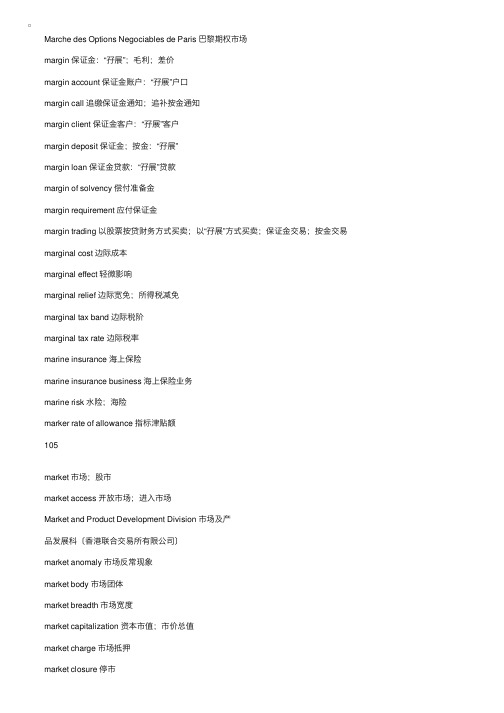
Marche des Options Negociables de Paris 巴黎期权市场 margin 保证⾦:“孖展”;⽑利;差价 margin account 保证⾦账户:“孖展”户⼝ margin call 追缴保证⾦通知;追补按⾦通知 margin client 保证⾦客户:“孖展”客户 margin deposit 保证⾦;按⾦:“孖展” margin loan 保证⾦贷款:“孖展”贷款 margin of solvency 偿付准备⾦ margin requirement 应付保证⾦ margin trading 以股票按贷财务⽅式买卖;以“孖展”⽅式买卖;保证⾦交易;按⾦交易 marginal cost 边际成本 marginal effect 轻微影响 marginal relief 边际宽免;所得税减免 marginal tax band 边际税阶 marginal tax rate 边际税率 marine insurance 海上保险 marine insurance business 海上保险业务 marine risk ⽔险;海险 marker rate of allowance 指标津贴额 105 market 市场;股市 market access 开放市场;进⼊市场 Market and Product Development Division 市场及产 品发展科〔⾹港联合交易所有限公司〕 market anomaly 市场反常现象 market body 市场团体 market breadth 市场宽度 market capitalization 资本市值;市价总值 market charge 市场抵押 market collateral 市场抵押品 market contract 市场合约 Market Development Division market discipline 市场规律 market disruption 市场⼲扰 market economy 市场经济 market efficiency 市场效率 market fluctuation 市场波动;市情升降 market forces 市场⼒量 market information 市场资料;市场信息;⾏情 market infrastructure 市场基础设施 market intermediary 市场中介者 market leader 市场主要股份;市场 market maker 市场作价者;市场“庄家” market malpractice 市场不当⾏为 market manipulation 操纵市场:“造市” market mechanism 市场机制;市场调节机能 market median 市场中位数 market member 市场会员 market on close 按收市盘 market order 市价盘;市价订单 market participant 市场⼈⼠ market practitioner 市场从业员 market premium 市场溢价 market price 市价;市场价格 market price development 市场价格变动 market rate 市价;市场利率;市场汇率 market rate of discount 市场贴现率 market rate of interest 市场利率 market rent 市值租⾦;市⾯租⾦ market risk 市场风险 market risk regime 市场风险制度 market sentiment 市场情绪 市场发展处〔⾹港⾦融管理局〕 106 Market Services Group 市场服务处〔⾹港联合交易所有限公司〕 market share 市场占有率 market statistics 市场统计;⾏情 market surveillance policy 市场监察政策 Market Systems Division 市场系统处〔⾹港⾦融管理局〕 market trend 市场趋势 market value 市值 market value adjustment 市值调整 marketability 适销性;流通性;销售能⼒ marketable debt securities 有价债务证券 marketable government debt 有价公债 marketable securities 有价证券 market-determined price 由市场决定的价格 market-disciplined economy 由市场⼒量⽀配的经济 market-disciplined free-enterprise economy 由市场因素决定的⾃由企业经济体系 market-friendly 有利市场运作 marketing organization facility 统营设施 market-making system 市场作价制度;市场“庄家”制度 market-orientation 以市场为主导 market-oriented economy 市场主导的经济体系 market-sensitive information 市场敏感资料;影响市场的数据 mark-to-market 按市价计值;按市价计算差额 marriage settlement 婚姻授产契 married person's allowance 已婚⼈⼠免税额 Mass Transit Fund 地下铁路基⾦ Mass Transit Railway Corporation note ⾹港地下铁路公司债券 massive downward pressure 强⼤的向下调整压⼒ match an order 对单;对盘 matching 对销;相配;对盘 matching grant 半费资助;等额津贴 matching system 对销系统;相配系统;对盘系统 material risk 重⼤风险 mathematical reserve 数理储备⾦ maturity 到期 maturity mismatch profile 期限错配组合 maturity mismatching arrangement 期限错配安排 maturity mismatching of assets and liabilities 资产与负债期限错配 maximum amount 款额 maximum benefit 利益 maximum rate of interest 利率 means test 经济状况调查 107 measure of risk exposure 衡量风险承担的⽅法 median income household 中位数⼊息家庭 median return 中位回报 Medium Range Forecast 中期预测 medium to long-term funds 中长期资⾦ meeting of creditors 债权⼈会议 member firm 会员商号 Members Affairs Committee 会员事务委员会〔⾹港期货交易所有限公司〕 Membership and Rules Committee 会籍及则例委员会〔⾹港期货交易所有限公司〕 Membership Committee 会籍委员会〔⾹港联合交易所有限公司〕 memorandum account 备查账户;备忘帐项 Memorandum Notes on the Revenue Estimates 税收预算备忘录 memorandum of agreement 协议备忘录;合约备忘录 memorandum of association 组织⼤纲;组织章程⼤纲 Memorandum of Regulatory Co-operation 《监管合作备忘录》 memorandum of satisfaction 清偿备忘录 Memorandum of Understanding Securities and Futures Commission> 《谅解备忘录》〔⾹港⾦融管理局与证券及期货事务监察 委员会签署〕 merchant bank 商⼈银⾏ merger 合并 merger agreement 合并协议 method of apportionment on a pro rata basis 按⽐例分摊计算办法 Michinoku Finance (Hong Kong) Limited 北⽇本财务(⾹港)有限公司 Micro Analysis Section 微观经济分析组〔财经事务局〕 microeconomics 微观经济学;个体经济学 midcap stock 中型股 middle interbank rate 银⾏同业中间利率 middle market cross-rate 中间市场套汇率 middle market rate 市场中间价格;市价中位数 middle rate 中间汇率 mid-market price 中期市场价格 mid-year review 年中检讨;中期经济检讨报告 Milan Stock Exchange ⽶兰证券交易所 minimum denomination 最低⾯额 minimum price movement 最低波动价位 minimum principal value 最低基本价值 minimum subscription 最低认购额 minority interest 少数权益;少数股东权益 108 minority shareholder controller ⼩股东控权⼈ miscellaneous expenses 杂项⽀出 miscellaneous fees 杂项费⽤ miscellaneous income 杂项收⼊ miscellaneous services 杂项服务 mismatch 错配 Mitsubishi Trust and Banking Corp. 三菱信托银⾏ Mitsubishi Trust Finance (Asia) Limited 三菱信托财务(亚洲)有限公司 Mitsui Trust and Banking Co., Ltd. 三井信托银⾏ Mitsui Trust Finance (Hong Kong) Limited 三井信托财务(⾹港)有限公司 mixed option 可延买亦可延卖的期权 mixed uptrend 反复向上 mode of payment 付款办法;发薪办法 Model Code for Securities Transactions by Directors of Listed Companies 《上市公司董事进⾏ 证券交易的标准守则》 moderate growth 轻微增长;稍微增长 moderating trend 下降趋势;放缓趋势 modification 修订;放宽 Modified Consumer Price Index 修订消费物价指数 modified factor system 修正因素计算法 monetary aggregate 货币总体数字;货币流通总额 monetary and financial system 货币⾦融体系 monetary arrangement ⾦融财务安排 monetary assets 货币资产 Monetary Authority ⾦融管理专员 monetary base 货币基础 monetary discipline 货币秩序 monetary instrument ⾦融票据;⾦融⼯具 Monetary Policy and Markets Department 货币政策及市场部〔⾹港⾦融管理局〕 Monetary Policy Division 货币政策处〔⾹港⾦融管理局〕 monetary regime 货币体制 monetary sector ⾦融界;⾦融体系 monetary situation 货币情况 monetary squeeze 货币紧缩;货币压缩 monetary stability ⾦融体制的稳定性 monetary unit 货币单位 monetary value 币值 monetization 货币化;币值化 monetized value 货币化价值。
金融词汇解释
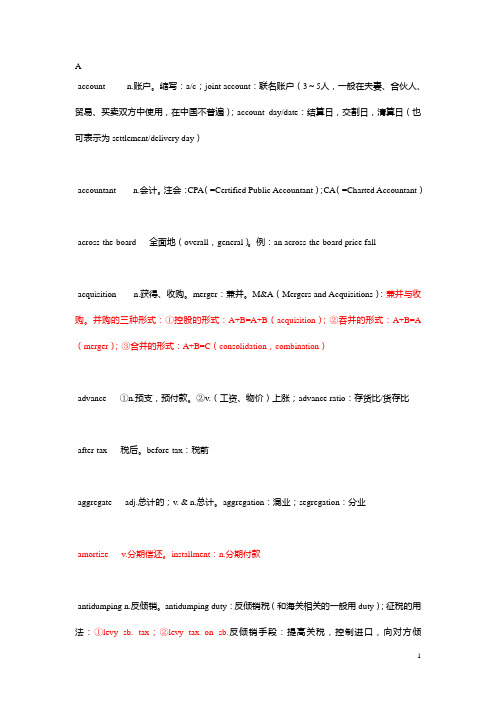
A·account n.账户。
缩写:a/c;joint account:联名账户(3~5人,一般在夫妻、合伙人、贸易、买卖双方中使用,在中国不普遍);account day/date:结算日,交割日,清算日(也可表示为settlement/delivery day)·accountant n.会计。
注会:CPA(=Certified Public Accountant);CA(=Charted Accountant)·across-the-board 全面地(overall,general)。
例:an across-the-board price fall·acquisition n.获得、收购。
merger:兼并。
M&A(Mergers and Acquisitions):兼并与收购。
并购的三种形式:①控股的形式:A+B=A+B(acquisition);②吞并的形式:A+B=A (merger);③合并的形式:A+B=C(consolidation,combination)·advance ①n.预支,预付款。
②v.(工资、物价)上涨;advance ratio:存货比/货存比·after-tax 税后。
before-tax:税前·aggregate adj.总计的;v. & n.总计。
aggregation:混业;segregation:分业·amortize v.分期偿还。
installment:n.分期付款·antidumping n.反倾销。
antidumping duty:反倾销税(和海关相关的一般用duty);征税的用法:①levy sb. tax;②levy tax on sb.反倾销手段:提高关税,控制进口,向对方倾销;·anti-laundering:反洗钱;anti-inflation:反通胀;anti-acquisition:反收购·appreciate v.增值(通常指货币)。
金融行业英语词汇
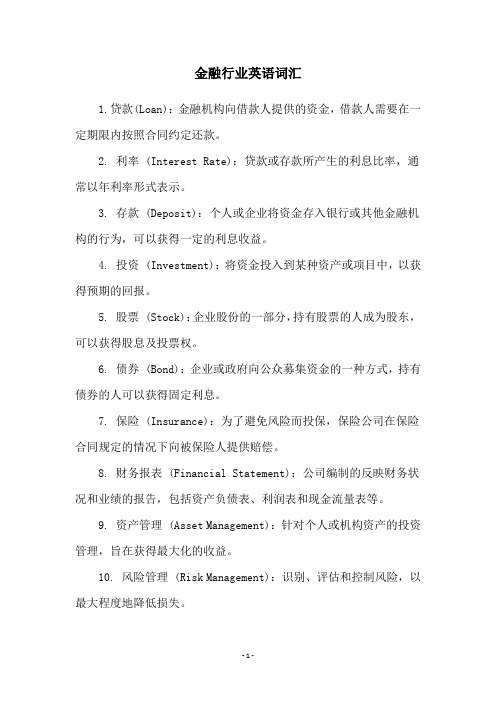
金融行业英语词汇
1.贷款(Loan):金融机构向借款人提供的资金,借款人需要在一定期限内按照合同约定还款。
2. 利率 (Interest Rate):贷款或存款所产生的利息比率,通常以年利率形式表示。
3. 存款 (Deposit):个人或企业将资金存入银行或其他金融机构的行为,可以获得一定的利息收益。
4. 投资 (Investment):将资金投入到某种资产或项目中,以获得预期的回报。
5. 股票 (Stock):企业股份的一部分,持有股票的人成为股东,可以获得股息及投票权。
6. 债券 (Bond):企业或政府向公众募集资金的一种方式,持有债券的人可以获得固定利息。
7. 保险 (Insurance):为了避免风险而投保,保险公司在保险合同规定的情况下向被保险人提供赔偿。
8. 财务报表 (Financial Statement):公司编制的反映财务状况和业绩的报告,包括资产负债表、利润表和现金流量表等。
9. 资产管理 (Asset Management):针对个人或机构资产的投资管理,旨在获得最大化的收益。
10. 风险管理 (Risk Management):识别、评估和控制风险,以最大程度地降低损失。
- 1 -。
常用的经济学金融学专业英语-中英文词汇及解释
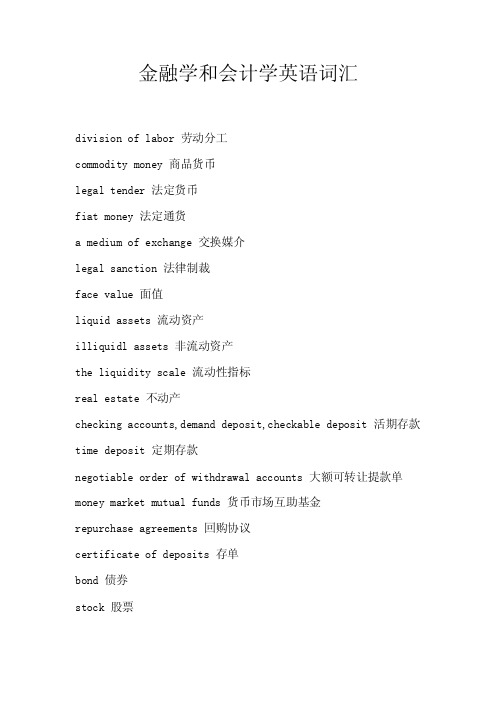
金融学和会计学英语词汇division of labor 劳动分工commodity money 商品货币legal tender 法定货币fiat money 法定通货a medium of exchange 交换媒介legal sanction 法律制裁face value 面值liquid assets 流动资产illiquidl assets 非流动资产the liquidity scale 流动性指标real estate 不动产checking accounts,demand deposit,checkable deposit 活期存款time deposit 定期存款negotiable order of withdrawal accounts 大额可转让提款单money market mutual funds 货币市场互助基金repurchase agreements 回购协议certificate of deposits 存单bond 债券stock 股票travelers'checks 旅行支票small-denomination time deposits 小额定期存款large-denomination time deposits 大额定期存款bank overnight repurchase agreements 银行隔夜回购协议bank long-term repurchase agreements 银行长期回购协议thrift institutions 存款机构financial institution 金融机构commercial banks 商业银行a means of payment 支付手段a store of value 储藏手段a standard of value 价值标准reserve 储备note 票据discount 贴现circulate 流通central bank 中央银行the Federal Reserve System 联邦储备系统credit union 信用合作社paper currency 纸币credit creation 信用创造branch banking 银行分行制unit banking 单一银行制out of circulation 退出流通capital stock 股本at par 以票面价值计electronic banking 电子银行banking holding company 公司银行the gold standard 金本位the Federal Reserve Board 联邦储备委员会the stock market crash 股市风暴reserve ratio 准备金比率deficit 亏损roll 展期wholesale 批发default 不履约auction 拍卖collateralize 担保markup 价格的涨幅dealer 交易员broker 经纪人pension funds 养老基金face amount 面值commerical paper 商业票据banker's acceptance 银行承兑汇票Fed fund 联邦基金eurodollar 欧洲美元treasury bills 国库券floating-rate 浮动比率fixed-rate 固定比率default risk 拖欠风险credit rating 信誉级别tax collection 税收money market 货币市场capital market 资本市场original maturity 原始到期期限surplus funds 过剩基金宏观经济的 macroeconomic通货膨胀 inflation破产 insolvency有偿还债务能力的 solvent合同 contract汇率 exchange rate紧缩信贷 tighten credit creation 私营部门 private sector财政管理机构 fiscal authorities宽松的财政政策 slack fiscal policy税法 tax bill财政 public finance财政部 the Ministry of Finance平衡预算 balanced budget继承税 inheritance tax货币主义者 monetariest增值税 VAT (value added tax)收入 revenue总需求 aggregate demand货币化 monetization赤字 deficit经济不景气 recession经济好转 turnabout复苏 recovery成本推进型 cost push货币供应 money supply生产率 productivity劳动力 labor force实际工资 real wages成本推进式通货膨胀 cost-push inflation 需求拉动式通货膨胀 demand-pull inflation 双位数通货膨胀 double- digit inflation极度通货膨胀 hyperinflation长期通货膨胀 chronic inflation治理通货膨胀 to fight inflation最终目标 ultimate goal坏的影响 adverse effect担保 ensure贴现 discount萧条的 sluggish认购 subscribe to支票帐户 checking account货币控制工具 instruments of monetry control 借据 IOUs(I owe you)本票 promissory notes货币总监 controller of the currency拖收系统 collection system支票清算或结算 check clearing资金划拨 transfer of funds可以相信的证明 credentials改革 fashion被缠住 entangled货币联盟 Monetary Union再购协议 repo精明的讨价还价交易 horse-trading欧元 euro公共债务 membership criteria汇率机制 REM储备货币 reserve currency劳动密集型 labor-intensive股票交易所 bourse竞争领先 frontrun牛市 bull market非凡的牛市 a raging bull规模经济 scale economcies买方出价与卖方要价之间的差价 bid-ask spreads 期货(股票) futures经济商行 brokerage firm回报率 rate of return股票 equities违约 default现金外流 cash drains经济人佣金 brokerage fee存款单 CD(certificate of deposit)营业额 turnover资本市场 capital market布雷顿森林体系 The Bretton Woods System经常帐户 current account套利者 arbitrager远期汇率 forward exchange rate即期汇率 spot rate实际利率 real interest rates货币政策工具 tools of monetary policy银行倒闭 bank failures跨国公司 MNC ( Multi-National Corporation) 商业银行 commercial bank商业票据 comercial paper利润 profit本票,期票 promissory notes监督 to monitor佣金(经济人) commission brokers套期保值 hedge有价证券平衡理论 portfolio balance theory 外汇储备 foreign exchange reserves固定汇率 fixed exchange rate浮动汇率 floating/flexible exchange rate 货币选择权(期货) currency option套利 arbitrage合约价 exercise price远期升水 forward premium多头买升 buying long空头卖跌 selling short按市价订购股票 market order股票经纪人 stockbroker国际货币基金 the IMF七国集团 the G-7监督 surveillance同业拆借市场 interbank market可兑换性 convertibility软通货 soft currency限制 restriction交易 transaction充分需求 adequate demand短期外债 short term external debt汇率机制 exchange rate regime直接标价 direct quotes资本流动性 mobility of capital赤字 deficit本国货币 domestic currency外汇交易市场 foreign exchange market国际储备 international reserve利率 interest rate资产 assets国际收支 balance of payments贸易差额 balance of trade繁荣 boom债券 bond资本 captial资本支出 captial expenditures商品 commodities商品交易所 commodity exchange期货合同 commodity futures contract普通股票 common stock联合大企业 conglomerate货币贬值 currency devaluation通货紧缩 deflation折旧 depreciation贴现率 discount rate归个人支配的收入 disposable personal income 从业人员 employed person汇率 exchange rate财政年度fiscal year自由企业 free enterprise国民生产总值 gross antional product 库存 inventory劳动力人数 labor force债务 liabilities市场经济 market economy合并 merger货币收入 money income跨国公司 Multinational Corproation 个人收入 personal income优先股票 preferred stock价格收益比率 price-earning ratio优惠贷款利率 prime rate利润 profit回报 return on investment使货币升值 revaluation薪水 salary季节性调整 seasonal adjustment关税 tariff失业人员 unemployed person效用 utility价值 value工资 wages工资价格螺旋上升 wage-price spiral收益 yield补偿贸易 compensatory trade, compensated deal 储蓄银行 saving banks欧洲联盟 the European Union单一的实体 a single entity抵押贷款 mortgage lending业主产权 owner's equity普通股 common stock无形资产 intangible assets收益表 income statement营业开支 operating expenses行政开支 administrative expenses现金收支一览表 statement of cash flow贸易中的存货 inventory收益 proceeds投资银行 investment bank机构投资者 institutional investor垄断兼并委员会 MMC招标发行 issue by tender定向发行 introduction代销 offer for sale直销 placing公开发行 public issue信贷额度 credit line国际债券 international bonds欧洲货币Eurocurrency利差 interest margin以所借的钱作抵押所获之贷款 leveraged loan 权利股发行 rights issues净收入比例结合 net income gearing常用的经济学金融学中英文词汇及解释Equilibrium,competitive 竞争均衡见竟争均衡(competitive equilibrium)。
金融英语词汇 含解释
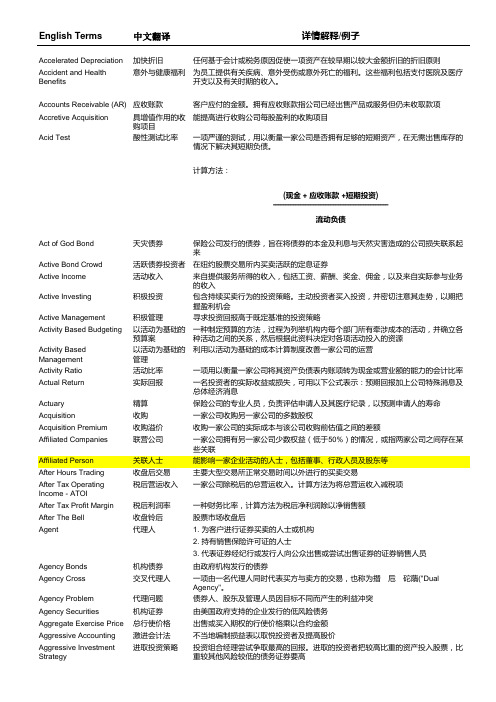
一项由一名代理人同时代表买方与卖方的交易,也称为撍卮砣藬("Dual Agency"。
债券人、股东及管理人员因目标不同而产生的利益冲突Average Price Call平均价格买入期权权一种期权,其收益为零或相等于资产平均价格高于行使价格的金额Average Price Put平均价格出售期权一种期权,其收益为零或相等于行使价格高于资产平均价格的金额Average Up提高平均价格以比原先买入价格高的价格买入更多股票,从而提高所有股票的平均价格Back Door Listing后门上市/借壳上市未能符合股票交易所上市要求的企业采用的一种上市策略,公司通过收购一家已经上市的公司而达到上市的目的Backlog订单积压等候完成的出售指示Back Office后线金融服务公司的行政及支援人员,主要职能包括交易结算、清理、记录、合规监察、会计等Back Pricing往后定价某些期货合约采用的方法,期货商品的价格由买方在签署合约后特定日期决定Back-to-Back Loan背对背贷款两家位于不同国家的公司向对方借贷相同金额的对方国家货币贷款,目的在于对冲货币波动的风险Backstop最后担保为一项证券发行提供最终的保证或担保Bad Debt不良贷款不能回收的债务,因此对债权人没有价值Balanced Fund平衡基金将资产投资于货币市场、债券、优先股及普通股的共同基金,目的在于同时实现增长及收益Balanced InvestmentStrategy平衡投资策略旨在平衡风险及回报的投资组合分配及管理方法Balance Of Payments (BOP)国际收支差额一个国家在特定期间进行的所有交易的纪录,可用作比较一个国家与其他国家的经济活动量Balance Of Trade (BOT)国际贸易差额一个国家收支差额的最大组成项目。
指出口及进口的差额。
减项包括进口、外国援助、国民在国外的开支及国民在国外的投资。
金融专业术语英语词汇

金融专业术语英语词汇unit onen of modity money商品货币legal tender法定货币fiat money法定通货a medium of exchange交换媒介legal n法律制裁face value面值liquid assets流动资产illiquidl assets非流动资产the liquidity scale流动性指标real XXX定期存款bond债券XXX payment支付手段a store of value储藏手段a standard of value价值标准certificate of deposits存单repurchase agreements回购协议travelers'checks旅行支票money market mutual funds货币市场互助基金small-XXX小额按期存款large-XXX大额定期存款XXX隔夜回购和谈XXX-XXX历久回购和谈checking accounts,demand deposit,XXX活期存款XXX大额可让渡提款单unit tworeserve储备note票据discount贴现circulate流通XXXpaper currency纸币credit XXX制unit banking单一银行制out of n退出畅通流畅capital stock股本at par以票面代价计XXXthe gold standard金本位reserve 筹办金比率XXXthe stock market crash股市风暴the Federal Reserve System联邦储蓄体系the XXXunit threedeficit吃亏roll展期wholesale批发default不履约merical paper商业票据XXX欧洲美元treasury bills国库券floating-rate浮动比率fixed-rate固定比率default risk拖欠风险credit rating信誉级别tax n税收money market货币市场capital market资本市场original maturity原始到期期限surplus funds过剩基金unit fourpremium升水discount贴水par平价deficit赤字XXXeurodollar market欧洲美元市场spot rate即期汇率forward rate远期汇率cross rate交叉汇率arbitrage n套汇交易space arbitrage地点套汇time arbitrage时间套汇interest arbitrage套利direct n直接标价法indirect n间接标价法decimal system十进制long n多头short n空头XXX丹麦克郎Nkr挪威克郎Yen日元Can$加拿大元Lit 意大利里拉Aus$澳大利亚元DG荷兰盾BF比利时法郎£英镑unit fiveover-the-counter market场外交易市场XXX总成交额invoice,债务,投资组合not-for-profit cooperative非盈利性组织triangular arbitrage三角套汇the XXX(SWIFT)XXX the clearing house interbank payments system(CHIPS)纽约银行同业清理体系unit sixquota配额guaratee保函fixed exchange rate牢固汇率balance of nal payment国际进出buffer stock缓冲存货extended facilities补偿信贷便利XXX国债;政府借款XXX价格波动,价格涨落export earning出口收益enlarged access policy延期进入政策credit policy信用政策financial nal terms特惠条件XXXearning capacity收益能力debt restructuring债务重组,债务调整financial settlement财务清算XXX布雷顿森林协议XXXXXXXXXXXXXXX(IBRD)国际复兴与开发银行unit seven。
《金融专业英语》单词汇总表

Rating Stock Dividend Principal Principal
n. n. n. n. adj. adj.
等级, 类别 公债,股份,股票,存货,供应物 红利, 股息 资本, 本金, 委托人 最重要的, 主要的 未偿付的, 困难未解决的, 工作未完成的 紧急援助 收购, 买入, 收购股权 (使)上市,把(证券)列入上市证券表 n. adj. n. 公开, 泄露, 揭露 衍生的, 导出的, 拷贝的 派生物,衍生物 (使)合并, (使)融合 n. n. 获得, 取得, 获得物 证券化, 资产证券化 支出,花费 n. n. n. n. 附属担保品,抵押品 契约,合同,正式凭单,文据 优先,优先权 评估, 评价 股份, 赌注, 风险
Depreciation Speculate Venture
Jasmine
- 4 -
《金融专业英语》
单词汇总表
Collect Draw Drawer Drawee Endorser Endorsee Payee Payer Acceptor n. n. v.
Appraisal Agency Regime n. n.
Administrative Governance Accrue Recession Depression Prosperity Recovery Allocation Distribution v. n.
Negotiable Commercial
v.
收款, 收帐 出票 出票人 受票人
Due Rate
adj. n. n. n. n. n. n. n. v. n. n. v. n. n. n. v. v. v. v. v. v.
证券金融英语知识 第13期:证券英语词汇(6)
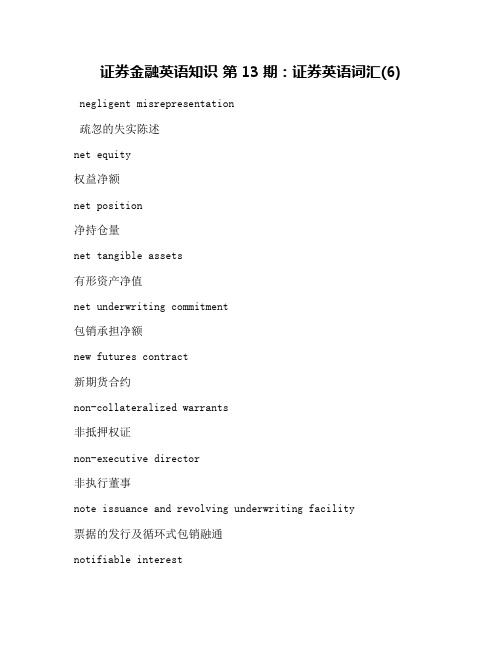
证券金融英语知识第13期:证券英语词汇(6) negligent misrepresentation疏忽的失实陈述net equity权益净额net position净持仓量net tangible assets有形资产净值net underwriting commitment包销承担净额new futures contract新期货合约non-collateralized warrants非抵押权证non-executive director非执行董事note issuance and revolving underwriting facility票据的发行及循环式包销融通notifiable interest须具报权益notifiable percentage level须具报百分率水平notional principal amount名义本金额number数目offer要约offer document要约文件证券2.jpgoffer price要约价offeree company要约标的公司offeror要约人off-exchange traded derivative contracts 场外买卖衍生工具合约off-exchange transaction场外交易officer高级人员Official Receiver破产管理署署长Official Trustee法定受托人off-market share repurchase场外股份购回off-market share repurchase circular 场外股份购回通告off-market transaction场外交易Ombudsman申诉专员omnibus account客户汇集综合账户on-exchange transaction场内交易options contract期权合约order命令ordinary member普通成员other collateral其它抵押品out-of-the-money amount 价外值overseas company海外公司overseas stock market 海外证券市场。
金融英语词汇解释
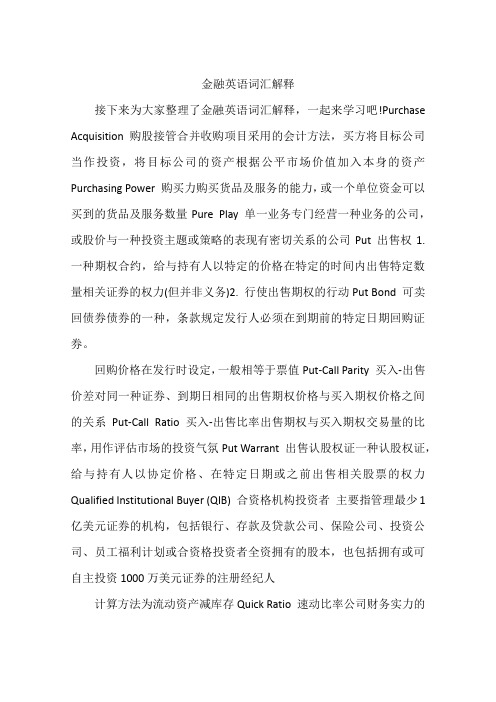
金融英语词汇解释接下来为大家整理了金融英语词汇解释,一起来学习吧!Purchase Acquisition 购股接管合并收购项目采用的会计方法,买方将目标公司当作投资,将目标公司的资产根据公平市场价值加入本身的资产Purchasing Power 购买力购买货品及服务的能力,或一个单位资金可以买到的货品及服务数量Pure Play 单一业务专门经营一种业务的公司,或股价与一种投资主题或策略的表现有密切关系的公司Put 出售权1. 一种期权合约,给与持有人以特定的价格在特定的时间内出售特定数量相关证券的权力(但并非义务)2. 行使出售期权的行动Put Bond 可卖回债券债券的一种,条款规定发行人必须在到期前的特定日期回购证券。
回购价格在发行时设定,一般相等于票值Put-Call Parity 买入-出售价差对同一种证券、到期日相同的出售期权价格与买入期权价格之间的关系Put-Call Ratio 买入-出售比率出售期权与买入期权交易量的比率,用作评估市场的投资气氛Put Warrant 出售认股权证一种认股权证,给与持有人以协定价格、在特定日期或之前出售相关股票的权力Qualified Institutional Buyer (QIB) 合资格机构投资者主要指管理最少1亿美元证券的机构,包括银行、存款及贷款公司、保险公司、投资公司、员工福利计划或合资格投资者全资拥有的股本,也包括拥有或可自主投资1000万美元证券的注册经纪人计算方法为流动资产减库存Quick Ratio 速动比率公司财务实力的指标。
计算方法为流动资产减库存,然后除以流动负债。
也称为酸性测试比率Quiet Filing 安静申请指促意不包括重要细节的首次公开上市申请。
发行人向美国证监会提交安静申请的目的在于展开新证券发行的申请过程,未提交资料必须在补充文件中披露。
这种申请方式所需的时间一般比传统申请方法要长Quiet Period 静止期在首次公开上市的过程中,静止期指美国证监会禁止发行人进行公开推销活动的时期。
金融英语词语解释全部版
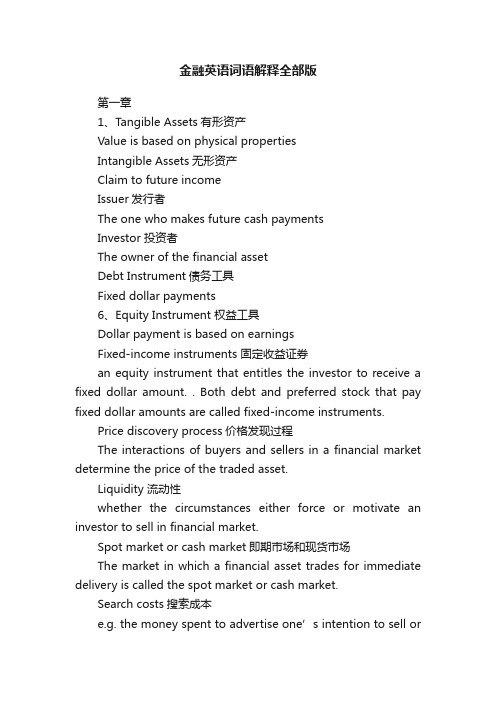
金融英语词语解释全部版第一章1、Tangible Assets有形资产Value is based on physical propertiesIntangible Assets无形资产Claim to future incomeIssuer发行者The one who makes future cash paymentsInvestor 投资者The owner of the financial assetDebt Instrument债务工具Fixed dollar payments6、Equity Instrument 权益工具Dollar payment is based on earningsFixed-income instruments 固定收益证券an equity instrument that entitles the investor to receive a fixed dollar amount. . Both debt and preferred stock that pay fixed dollar amounts are called fixed-income instruments.Price discovery process价格发现过程The interactions of buyers and sellers in a financial market determine the price of the traded asset.Liquidity 流动性whether the circumstances either force or motivate an investor to sell in financial market.Spot market or cash market即期市场和现货市场The market in which a financial asset trades for immediate delivery is called the spot market or cash market.Search costs搜索成本e.g. the mone y spent to advertise one’s intention to sell orpurchase a financial asset;the value of time spent in locating a counterparty11、 derivative instrument衍生品工具A derivative instrument is a financial asset whose value derives from the value of some other asset . The contract holder has either the obligation or the choice to buy or sell a financial asset at some future time.futures/forward contracts 期货/远期合约Futures/forward contracts are obligations that must be fulfilled at maturity, it is a contract that exchanges an asset or commodity at a fixed price in the future.13、 Options contracts期权合约Options contracts are rights, not obligations, to either buy or sell a financial asset at a specified price. The buyer of the contract must pay the seller a fee, which is called the option price.14、Call option看涨期权The option grants the owner of the option the right to buy a financial asset from the other party.15、Put option看跌期权The option grants the owner of the option the right to sell a financial asset from the other party.16、Disclosure regulation信息披露监管It requires issuers of securities to make public a large amount of financial information to actual and potential investors.17、Financial activity regulation金融行为(活动监管)It consists of rules about traders of securities and trading on financial markets.18、Regulation of financial institutions金融机构监管It is the form of governmental monitoring that restricts these institutions’ activities in the vital areas of lending, borrowing,and funding.19、Regulation of foreign participants外国参与者监管It is the form of governmental activity that limits the roles foreign firms can have in domestic markets and their ownership or control of financial institutions.20、Banking and monetary regulation银行与货币监管Authorities use it to try to control cha nges in a country’s money supply, which is thought to control the level of economic activity.21、Asymmetric information信息不对称Investors and managers have uneven access to or uneven possession of information.23、Agency problem代理问题The firm’s managers who act as agents for investors, may act in their own interests to the disadvantage of the investors.第二章1、Financial intermediaries 金融中介A special and important type of financial institutionTransforming financial assets acquired through the market and constituting 组合them into a different, and more widely preferable, type of asset, which becomes their liability.1 Depository institutions存款机构Acquire the bulk of their funds by offering their liabilities to the public mostly in the form of deposits.2 Direct investments直接投资Intermediaries obtain funds from market participants and invest these funds3 Indirect investments间接投资Market participants who give their funds to the intermediaries and who thereby hold claims on these institutions4、commercial bank商业银行accepts deposits and uses the proceeds to lend funds to consumers and businesses.5、Investment company投资公司It pools the funds of market participants and uses those funds to buy a portfolio of securities such as stocks and bonds.6、Maturity intermediation期限中介The investor (depositor) often wants only a short-term claim, which the intermediary can turn into a claim on long-term assets. This function of a financial intermediary is called maturity intermediation7、Diversification分散化投资Transforming more risky assets into less risky ones.8、Information processing costs信息处理成本e.g. the opportunity cost of the time to process the information about the financial assets and its issuer, and the cost of acquiring that information.9、Contracting costs签约成本The costs of writing loan contracts or the costs of enforcing the terms of the loan agreement.9、Payment mechanisms支付机制The methods for making payments are provided by certain financial intermediaries10、Liabilities负债It means the amount and time of the cash outlays that must be made to satisfy the contractual terms of the obligations issued11、Asset/Liability management资产/负债管理The nature of the liabilities dictates the investment strategya financial institution will pursue12、Guaranteed investment contract (GIC)保障收益合同Both amounts of cash outflows and timing are known (Type I )The obligation of the life insurance company under this contract is that, for a sum of money (called a premium), it will guarantee an interest rate up to some specified maturity date13、certificates of deposit定期存单Cash outflows are not known, but timing is known (Type III)It has a stated maturity, the interest rate paid need not be fixed over the life of the deposit but may fluctuate14、Credit risk信用风险It is the risk that the obligor of a financial instrument held by a financial institution will fail to fulfill its obligation on the due date or at any time thereafter15、Settlement risk交割风险It is the risk that when there is a settlement of a trade or obligation, the transfer fails to take place as expected.It consists of counterparty risk and a form of liquidity risk.16、Counterparty risk交易对手违约风险It is the risk that a counterparty in a trade fails to satisfy its obligation17、Liquidity risk流动性风险In the context of settlement risk, it means that the counterparty can eventually meet its obligations, but not at the due date.In addition to being a part of settlement risk, it has two forms: market liquidity risk and funding liquidity risk.18、Market liquidity risk 市场流动性风险It is the risk that a financial institution is unable to transact in a financial instrument at a price near its market value19、Funding liquidity risk融资流动性风险 (资金流动性风险)It is the risk that the financial institution will be unable to obtain funding to obtain cash flow necessary to satisfy its obligations20、Market risk市场风险It is the risk to a financial institution’s economic well being that results from an adverse movement in the market price of the asset it owns or the level or the volatility of market prices. There are measures that can be used to gauge this risk.21、value-at-risk风险价值It is one of measures that can be used to gauge market riskA measure of the potential loss in a financial institution’s financial position associated with an adverse price movement ofa given probability over a specified time horizon22、Operational risk操作风险It is the risk of loss resulting from inadequate or failed internal processes, people and systems, or from external events Classified by the cause of the loss event: employees, business process, relationships, technology, and external factors23、legal risk法律风险This is the risk of loss resulting from failure to comply with laws as well as prudent ethical standards and contractual obligations24、Incentive fee激励费It is a share of the positive return which performance-based compensation in the management fee structure for hedge funds25、Absolute return绝对收益It is simply the return realized26、Relative return相对收益It is the difference between the absolute return and thereturn on some benchmark or index27、Market directional hedge fund市场导向型对冲基金It is one in which the asset manager retains some exposure to systemic risk28、Corporate restructuring hedge fund公司重组型对冲基金It is one in which the asset manager positions the portfolio to capitalize on the anticipated impact of a significant corporate event. These events include a merger, acquisition, or bankruptcy29、Convergence trading hedge fund收敛交易型对冲基金It uses a strategy to take advantage of misalignment of prices or yields, an arbitrage strategy.technically, arbitrage means riskless profit. Some strategies used by hedge funds do not really involve no risk, but instead low risk strategies of price misalignments误差30、Opportunistic hedge fund机会主义型对冲基金It has the broadest mandate of all of the four hedge fund categories. Asset managers of hedge funds can make specific bets on stocks or currencies or they could have well-diversified portfolios. These include fund of funds, and global macro hedge funds that invest opportunistically based on macroeconomic considerations in any world market.第三章1、Spread income利差收入MarginIt should allow the depository institution to meet operating expenses and earn a fair profit on its capital2、Regulatory risk监管风险It is the risk that regulators will change the rules so as to adversely impact the earnings of the institution3、Secondary reserves次级储备Securities held for the purpose of satisfying net withdrawals and customer loan demands4、Individual Banking个人银行业务It encompasses residential mortgage lending, consumer installment loans, credit card financing, brokerage services, student loans,5、Institutional banking企业银行业务It includes commercial real estate financing, leasing activities, and factoring, etc.5、Global banking国际业务It includes corporate financing, capital market and foreign exchange products and services.Most global banking activities generate fee income rather than interest income.5、Demand deposits活期存款Checking accountspay no interest and can be withdrawn upon demand6、Savings deposits储蓄存款pay interest, typically below market interest rates, do not have a specific maturity, and usually can be withdrawn upon demand7、Time deposits定期存款also called certificates of deposit, have a fixed maturity date and pay either a fixed or floating interest rate8、Reserve ratio准备金率It is the specified percentage of deposits in a non-interest-bearing account at one of the 12 Federal Reserve Banks that a bank must maintainIt is established by the Federal Reserve Board9、Required reserve法定准备金The dollar amount based on the reserve ratio that are required to be kept on deposit at a Federal Reserve Bank10、deposit computation period存款计算周期To compute the required reserve, the Federal Reserve has established a two-week period11、excess reserves超额准备金The difference is that actual reserves exceed required reserves12、Federal funds market联邦基金市场Banks temporarily short of their required reserves can borrow reserves from banks that have excess reserves The market where banks can borrow or lend reserves is called thefederal funds market13、Federal funds rate联邦基金利率The interest rate charged to borrow funds in the federal funds market14、Discount window贴现窗口The Federal Reserve Bank is the bank of last resort. Banks temporarily short of funds can borrow from the Fed at its discount window.Collateral is necessary to borrow, but not just any collateral will do, and the Fed sets the criteria for collateral quality15、Discount rate贴现率The interest rate that the Fed charges to borrow funds at the discount window16、Money center banks货币中央银行The banks that raise most of their funds from the domestic and international money markets, relying less on depositors forfunds17、Regional bank区域性银行It is one that relies primarily on deposits for funding, and makes less use of the money markets to obtain funds18、Superregional banks超级区域性银行Larger regional banks have been merging with other regional banks to form Superregional banks19、Core Capital核心资本金Tier 1 CapitalIt consists of common stockholders’ equity, certain types of preferred stock, and minority interest in consolidated subsidiaries20、Supplementary Capital补充资本金Tier 2 capitalIt includes loan-loss reserve, certain types of preferred stock, perpetual debt, hybrid capital instruments, equity contract notes, and subordinated debt21、Natural person credit unions自然人信用合作社Federal and state chartered credit unions are called natural person credit unionsProvide financial services to qualifying members of the general public22、Corporate credit unions 公司信用合作社Provide a variety of investment services, as well as payment systems, only to natural person credit unions第六章1、Premiums保费Insurance companies sell insurance policies, which are legallybinding contracts for which the policyholder pays insurance premiums2、Risk bearers 风险承担者According to the insurance contract, insurance companies promise to pay specified sums contingent on the occurrence of future events, such as death or an automobile accident. For insurance companies, they accept or underwrite给...保险;承诺支付the risk in return for an insurance premium2、Underwriting process销售过程It is deciding which applications for insurance they should accept and which ones they should reject, and if they accept, determining how much they should charge for the insurance3、Life Insurance人寿保险For life insurance, the risk insured against is the death of the “insured”.4、Health insurance健康保险In the case of health insurance, the risk insured is medical treatment of the insured.5、Property and casualty insurance财产与意外伤害保险The risk insured by Property and casualty (P&C) insurance companies is damage to various types of property. Specifically, it is insurance against financial loss caused by damage, destruction, or loss toproperty as the result of an identifiable event that is sudden, unexpected, or unusual.6、Liability Insurance责任保险The risk insured against is litigation, or the risk of lawsuits against the insured due to actions by the insured or others.7、Disability Insurance伤残险It insures against the inability of employed persons to earnan income8、Long-Term Care Insurance长期护理保险It provides custodial care for the aged who are no longer able to care for themselves9、Annuity年金It is often described as a mutual fund in an insurance wrapper. It is treated as an insurance product and as a result receives a preferential tax treatment. Specifically, the income and realized gains are not taxable if not withdrawn from the annuity product. It can be either fixed, or variable.10、Bankassurance 银行保险Insurance companies are attracted by commercial bank customer contacts. As a result, commercial bank distribution of insurance company products has grown considerably.11、Stock Insurance Company股份保险公司It is similar in structure to any corporation or public company. Shares (of ownership) are owned by independent shareholders and are traded publicly. The shareholders care only about the performance of their shares, that is, the stock appreciation and the dividends. The insurance policies are simply the products or business of the company.11、Reinsure 再保险Some insurance companies may reinsure some or all of the liabilities they incur in providing insurance. According to the reinsurance transaction, the initial insurer 保险公司,承保人transfers the risk of the insurance to another company,。
金融专业英语名词解释
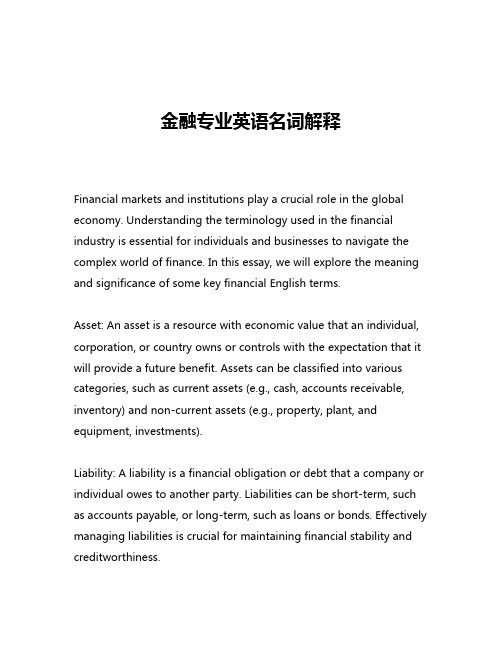
金融专业英语名词解释Financial markets and institutions play a crucial role in the global economy. Understanding the terminology used in the financial industry is essential for individuals and businesses to navigate the complex world of finance. In this essay, we will explore the meaning and significance of some key financial English terms.Asset: An asset is a resource with economic value that an individual, corporation, or country owns or controls with the expectation that it will provide a future benefit. Assets can be classified into various categories, such as current assets (e.g., cash, accounts receivable, inventory) and non-current assets (e.g., property, plant, and equipment, investments).Liability: A liability is a financial obligation or debt that a company or individual owes to another party. Liabilities can be short-term, such as accounts payable, or long-term, such as loans or bonds. Effectively managing liabilities is crucial for maintaining financial stability and creditworthiness.Equity: Equity represents the ownership interest in a company. It is the residual value of a company's assets after deducting its liabilities. Equity can be in the form of common stock, preferred stock, or retained earnings. Investors often use equity as a measure of a company's financial health and growth potential.Income Statement: The income statement, also known as the profit and loss statement, is a financial report that summarizes a company's revenues, expenses, and net income (or loss) over a specific period, typically a quarter or a year. The income statement helps stakeholders understand a company's profitability and financial performance.Balance Sheet: The balance sheet is a financial statement that presents a company's assets, liabilities, and shareholders' equity at a specific point in time. It provides a snapshot of a company's financial position, allowing stakeholders to assess its liquidity, solvency, and overall financial health.Cash Flow Statement: The cash flow statement is a financial report that shows the movement of cash in and out of a company over a specific period. It categorizes cash flows into three main activities: operating, investing, and financing. The cash flow statement helps stakeholders understand a company's ability to generate and use cash, which is crucial for its long-term sustainability.Dividend: A dividend is a distribution of a portion of a company's earnings to its shareholders. Companies may pay dividends in cash, stock, or other forms. Dividends are an important consideration for investors as they can provide a steady stream of income and signal the financial health of a company.Interest Rate: The interest rate is the amount charged by a lender to a borrower for the use of money. Interest rates are a crucial factor in the financial markets, as they influence the cost of borrowing, the return on savings, and the valuation of financial instruments.Inflation: Inflation is the sustained increase in the general price level of goods and services in an economy over time. High inflation can erode the purchasing power of a currency and affect the real value of investments and savings.Recession: A recession is a significant decline in economic activity, characterized by a drop in gross domestic product (GDP), increased unemployment, and decreased consumer spending. Recessions can have far-reaching consequences for businesses, individuals, and the overall economy.Quantitative Easing (QE): Quantitative easing is a monetary policy tool used by central banks to stimulate the economy. It involves thecentral bank purchasing government bonds or other financial assets from the market to increase the money supply and lower interest rates, thereby encouraging economic growth.Derivative: A derivative is a financial instrument whose value is derived from the value of an underlying asset, such as a stock, bond, commodity, or currency. Derivatives can be used for hedging, speculation, or risk management purposes.Hedge Fund: A hedge fund is an actively managed investment fund that pools money from investors and invests in a variety of assets, often using complex trading strategies, such as short-selling and leverage, to generate returns.Initial Public Offering (IPO): An initial public offering (IPO) is the first sale of stock by a private company to the public. It allows the company to raise capital and provides an opportunity for investors to participate in the company's growth.In conclusion, the financial English terminology discussed in this essay represents only a small fraction of the vast and complex language used in the financial industry. Understanding these key terms is essential for individuals and businesses to navigate the financial landscape effectively and make informed decisions. As thefinancial world continues to evolve, it is crucial to stay informed and adaptable to the changing terminology and concepts.。
金融英语词汇(含解释)
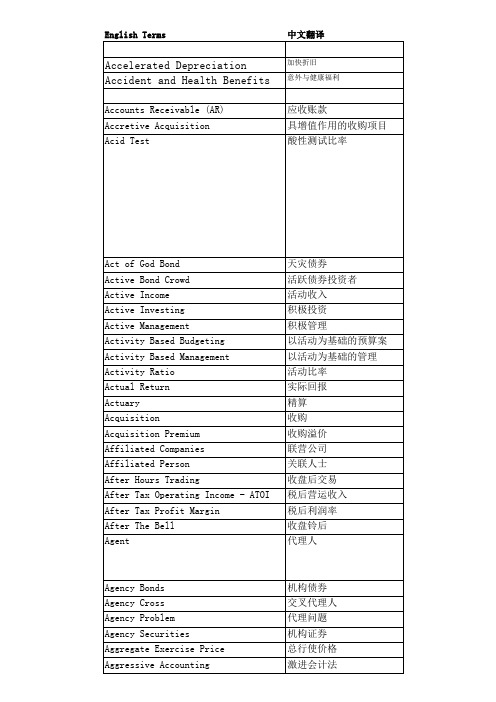
Call Date 买回日期Call Loan 短期同业拆借,通知贷款Call Loan Rate 短期同业拆借利率,通知贷款利率Call Option 买入期权Call Warrant 买入认股权证Callable Bond可买回债券Callable Preferred Stock 可买回优先股CAMELS Rating System CAMELS评级制度Capital Account资本帐户Capital Adequacy Ratio (CAR)资本充足率Capital Appreciation 资本升值Capital Asset资本资产Capital Budgeting 资本预算Capital Expenditure 资本开支Capital Gain 资本收益Capital Goods资本财货Capital Guarantee Fund 资本保证基金Capital Intensive 资本密集Capital Loss 资本损失Capital Lease 资本化租赁Capital Markets 资本市场Capital Note 资本票据Capitalism 资本主义Capitalize 资本化Capped Option有上限期权Call Premium 买回溢价Capital 资本/资本金Capital Asset Pricing Model (CAPM)资本资产计价模型Capital Base 资本金基础Capital Employed运用资本Capitalization 总资本,总市值Conversion转换Conversion Premium转换溢价Conversion Price转换价格Convertible Bond可转换债券Convertible Debenture可转换公司信用债券Convertible Preferred Stock可转换优先股Convertible Subordinated Note可转换次级票据Convertibles可转换证券Conveyance地产让与证书Contingency偶然事故Corporate Bond企业债券Corporate Cannibalism企业自我竞争Corporate Finance企业融资Corporate Governance企业治理Corporate Tax公司税Corporation公司、企业Cost Basis成本基础Cost of Capital资本成本Cost of Equity股本成本Cost of Funds资金成本Cost of Goods Sold (COGS)已售商品成本Cost Synergy成本协同效益Counterparty Risk交易对手风险Country Risk国家风险Coupon息票Coupon Bond有息票债券Covenant契约Coverage Initiated纳入研究范围Credit信贷、信用、贷项Credit Default Swap信贷违约掉期Credit Derivative信贷衍生工具Credit Enhancement加强信贷措施Credit Card信用卡Credit Cliff信用悬崖Credit Crunch紧缩信贷Cyclical Unemployment周期性失业DJIA道琼斯工业平均指数DJTA道琼斯交通平均指数DJUA道琼斯公用事业平均指数Data Mining数据探索Days Payable Outstanding (DPO)应付账款天数Days Sales Outstanding (DSO)应收账款天数Debenture公司债券Debit借项、借方Debt债务Debt Equity Ratio债务股本比Debt Equity Swap债换股交易Debt Financing债务融资Debt Ratio负债比率Debt Restructuring债务重组Debt Security债务证券Debt Service还本付息Debt Service Coverage Ratio债务偿付比率Debtor债务人Debt Overhang债务积压Declaration Date股息宣告日Deep Discount Bond高折扣债券Default违约,未能履行合约Default Risk违约风险Voting Trust Agreement投票信托协议Vulture Capitalist兀鹫投资者Vulture Fund兀鹫基金WACC加权平均资本成本WTO世界贸易组织Wall Street华尔街War Bond战争债券Warrant认股权证Warrant Coverage认股权证比重Warrant Premium认股权证溢价Wealth Added Index (WAI)财富增值指数Wealth Effect财富效应Wealth Management财富管理Weighted Average Cost of Capital (WACC)加权平均资本成本Weighted Average Market Capitalization加权平均总市值将一个投资组合分为不同资产种类的过程,主要资产种类包括债券、股票或现金。
金融英语重点单词名词解释

金融英语重点单词名词解释文件排版存档编号:[UYTR-OUPT28-KBNTL98-UYNN208]Currency:货币 The money used in a country-euros,dollars,yen, its C.. Overtime;加班时间 money received for working extra hours.Pension;养老金 money paid by a company or the government to a retired P..Mortgage;租金 repayments of money borrowed to buy a house or flat. Budget;预算 a financial plan, showing how much money a person or organization expects to earn and spend is called a budget. Shareholders;股东 the people who invest money in shares are called shareholders.Revenue;收入all the money coming into a company during a given period is revenue.Dividend股利 the part of its profit that a company pays to its shareholders is a D. Balance sheet资产负债表shows the company’s assets-the thing it owes, its liabilities-the money it owes; its capital.Assets 资产the capital a bank has and the loans it has made areit’s AAuditing审计A means examining a company’s systems of control and the accuracy or exactness of its records.External audit 外部审计is done by independent auditors; auditors who are not employees of the company.Partnerships合伙企业a P is a business arrangement in which several people work together, and share the risks and profits.Depreciation折旧reducing the value of assets in the company’s accounts.Full-disclosure principle全面披露the F principle states thatfinancial reporting must include all significant information; anything that makes a difference to the users of financial statements.Revenue recognition principle收入确认原则is that reyenue is recognized in the accounting period in which it is earned.Matching principle配比原则 which is related to revenue recognition states that each cost or expense related to revenue earned must be recorded in the same accounting period as the revenue it helped to earn.’Current assets流动资产which will be used or converted into cash in less than a year.External auditors外部审计人员independent auditors who do not work for the company Ledger 总分类账a book of accountsLiabilities;负债L are obligations to pay other organizations or people, money that the company owes, or will owe at a fate date Suppliers 供应商companies which provide raw materials or parts.Good will 商誉; the amount a company pays for another one, in excess of the net value of its assets.Retained earnings;留存收益profits from previous years that have not been distributedTangible assets有形资产 are assets with a physical existence-things you can touch-such as property, plant and equipmentCurrent liabilities流动短期负债C are expected to be paid within a year of the date of the balance sheetCreditors 应付账款largely suppliers of goods or services to the business who are not paid at the time of purchaseDeferred taxes应交税金 money that will have to be paid as tax in the future, although the payment does not have to be made now.Share premium股本溢价money made if the company sells shares at above their face value- the value written on themRetained earnings留存收益profits from previous years that have not been distributed to shareholdersReserves 公积金funds set aside from share capital and earnings, retained for emergencies or other future needsSolvency 偿债能力whether a company has enough cash to pay short-term debts, or whether it could go bankrupt-haye its assets sold to repay creditorsDirect costs直接成本those that can be directly related to the production of particular units of a product-are quite easy to calculateIndirect costs间接成本or Overheads管理费用costs and expense that cannot be identified with particular manufacturing processes or units of productionBreakeven point 盈亏平衡点is the sales volume-the number of units sold-at which the company covers its costs-pays all its expenses Withdraw money取钱Bank account银行存款at a commercial or retail bank ,and the bank generally pays interest to the depositorsGrand loans发放贷款lend money to borrowers who need more money than they have availableMerger 合并when two or more companies join togetherTakeover bid 收购 when one company offers to acquire or buy another oneDeregulated 放松管制there are now fewer restrictions and regulations than beforeUnderwrite 承销in other words, we guarantee to buy the securities ourselves if we can’t find other purchasersPension funds养老基金companies that invest money that will later be paid to retired workersFinancial stability金融稳定this involves changing interest rates. Exchange rate 汇率the price at which their currency can be converted into other currenciesDemand 需求how much is being boughtDiscount rate 贴现率is the rate the central bank sets to lend short-term funds to commercial banksSolvency偿付能力having sufficient cash available when debts have to be paidMoney markets 货币市场the M consist of a network of corporations, financial institutions ,investors and governments, which need to borrow or invest short-term capitalCommercial paper 商业票据C is a short-term loan issued by major companies ,also sold at a discount ,it is unsecured which means it is not guaranteed by the company’s assets。
金融英语词汇解释

金融英语词汇解释金融指货币的发行、流通和回笼,贷款的发放和收回,存款的存入和提取,汇兑的往来等经济活动。
接下来小编为大家整理了金融英语词汇解释,一起来学习吧!Purchase Acquisition 购股接管合并收购项目采用的会计方法,买方将目标公司当作投资,将目标公司的资产根据公平市场价值加入本身的资产Purchasing Power 购买力购买货品及服务的能力,或一个单位资金可以买到的货品及服务数量Pure Play 单一业务专门经营一种业务的公司,或股价与一种投资主题或策略的表现有密切关系的公司Put 出售权1. 一种期权合约,给与持有人以特定的价格在特定的时间内出售特定数量相关证券的权力(但并非义务)2. 行使出售期权的行动Put Bond 可卖回债券债券的一种,条款规定发行人必须在到期前的特定日期回购证券。
回购价格在发行时设定,一般相等于票值Put-Call Parity 买入-出售价差对同一种证券、到期日相同的出售期权价格与买入期权价格之间的关系Put-Call Ratio 买入-出售比率出售期权与买入期权交易量的比率,用作评估市场的投资气氛Put Warrant 出售认股权证一种认股权证,给与持有人以协定价格、在特定日期或之前出售相关股票的权力Qualified Institutional Buyer (QIB) 合资格机构投资者主要指管理最少1亿美元证券的机构,包括银行、存款及贷款公司、保险公司、投资公司、员工福利计划或合资格投资者全资拥有的股本,也包括拥有或可自主投资1000万美元证券的注册经纪人Qualitative Analysis 定性分析根据非财务信息,例如管理质量、行业周期性、研发实力及劳工关系,利用主观判断评估证券的分析方法Quality of Earnings 盈利质量销售量较高或成本较低造成盈利的金额,相对于利用不常规会计方法,例如夸张库存造成的人造利润Quantitative Analysis 定量分析指利用公司年报及损益表提供的财务资料作出投资决策的证券分析方法Quarter (Q1, Q2, Q3, Q4) 季度(第一季度、第二季度、第三季度、第四季度)财政日历内的三个月时期,作为申报盈利及支付股息的基准时期Quick Assets 速动资产可以迅速转换成为现金或已属于现金形式的资产。
金融英语名词解释
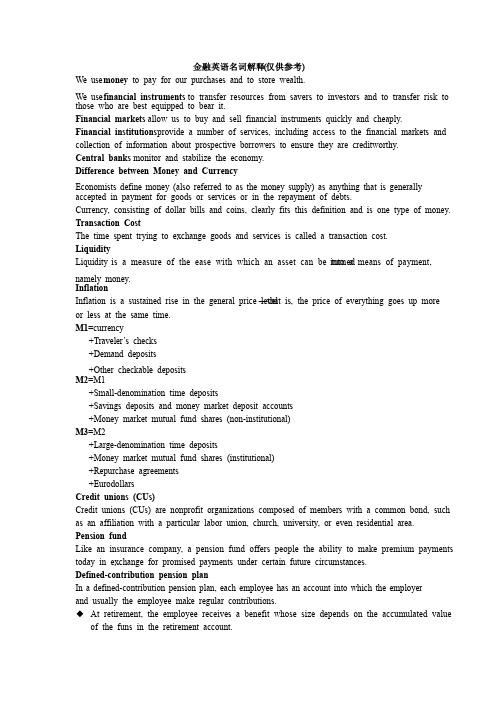
金融英语名词解释(仅供参考) We use money to pay for our purchases and to store wealth. We use financial instruments to transfer resources from savers to investors and to transfer risk to those who are best equipped to bear it. Financial markets allow us to buy and sell financial instruments quickly and cheaply. Financial institutions p rovide a number of services, including access to the financial markets and provide a number of services, including access to the financial markets and collection of information about prospective borrowers to ensure they are creditworthy. Central banks monitor and stabilize the economy. Difference between Money and Currency Economists Economists define define define money money money (also (also (also referred referred referred to to to as as as the the the money money money supply) supply) supply) as as as anything anything anything that that that is is is generally generally accepted in payment for goods or services or in the repayment of debts. Currency, consisting of dollar bills and coins, clearly fits this definition and is one type of money. Transaction Cost The time spent trying to exchange goods and services is called a transaction cost. Liquidity Liquidity Liquidity is a measure of the ease with which an asset can be turned is a measure of the ease with which an asset can be turned into a means of payment, namely money. Inflation Inflation is a sustained rise in the general price level —that is, the price of everything goes up more or less at the same time. M1=currency +Traveler’s checks+Demand deposits +Other checkable deposits M2=M1 +Small-denomination time deposits +Savings deposits and money market deposit accounts +Money market mutual fund shares (non-institutional) M3=M2 +Large-denomination time deposits +Money market mutual fund shares (institutional) +Repurchase agreements +Eurodollars Credit unions (CUs) Credit unions (CUs) are nonprofit organizations composed of members with a common bond, such as an affiliation with a particular labor union, church, university, or even residential area. Pension fund Like an insurance company, a pension fund offers people the ability to make premium payments today in exchange for promised payments under certain future circumstances. Defined-contribution pension plan In In a a defined-contribution defined-contribution pension pension pension plan, plan, plan, each each each employee employee employee has has has an an account account into into into which which which the the the employer employer and usually the employee make regular contributions. ◆ At retirement, the employee receives a benefit whose size depends on the accumulated value of the funs in the retirement account. Defined-benefit pension planIn a defined-benefit pension plan, the employee’s pension benefit is determined by a formula that takes into account years of service to the employer and, in most cases, wages or salary. ◆ A typical formula would be 1% of average retirement salary for each year of service. Mutual fundA mutual fund is a portfolio of stocks, bonds, or other assets purchased in the name of a group of investors and managed by a professional investment company or other financial institution. Securities brokersSecurities brokers are pure intermediaries who act as agents for investors in the purchase or sale of securities. Their Their function function function is is is to to to match match match buyers buyers buyers with with with sellers, sellers, sellers, a a a function function function for for for which which which they they they are are are paid paid paid brokerage brokerage commissions. Security dealersSecurity dealers link buyers and sellers by standing ready to buy and sell securities at given prices. Dealers hold inventories of securities and make their living by selling these securities for a slightly higher price than they paid for them. Organized exchangeAn organized exchange actually functions as a hybrid of an auction market (in which buyers and seller trade with each other in a central location); dealer marketA A dealer dealer dealer market market market (in (in (in which which which dealers dealers dealers make make make the the the market market market by by by buying buying buying and and and selling selling selling securities securities securities at at at given given prices). Legal reservesAll All depository depository depository institutions institutions institutions offering offering offering selected selected selected kinds kinds kinds of of of deposits deposits deposits are are are required required required to to to hold hold hold a a a small small percentage of those deposits in an asset account of the central bank known as legal reserves. Discount rateDiscount rate is the interest rate charged by a central bank on loans to commercial banks. money marketsFirms and individuals use the money markets primarily to warehouse funds for short periods of time until a more important need or a more productive use for the funds arises. Capital marketsFirms Firms and and and individuals individuals individuals use use use the the the capital capital capital markets markets markets for for for long-term long-term long-term investments. investments. investments. The The The capital capital capital markets markets provide an alternative to investment in assets such as real estate or gold. The capital market is the market in which long-term debt (generally those with original maturity of one year or greater) and equity instruments are traded. 什么叫Treasury Bills (T-bills)Face valueThe face value, or par value, of a bond is the value of the bond at maturity, the date when the loan is paid off. A common face value is $1,000 per bond. Coupon rateA bond’s coupon rate refers to the amount of interest that will be paid based on the face value of the bond. Common stockCommon stock makes up the majority of stocks. As a common stock holder, you have a right to claim dividends and get to have one vote per share when electing board of directors. Preferred stockPreferred stock does not usually include voting rights and pays a specified dividend, because of which the stock price does not rise and fall along with the company profits. Bear marketA bear market indicates the continuous downward movement of the stock market. Bull marketA bull market indicates the constant upward movement of the stock market. A particular stock that seems to be increasing in value is described to be bullish while a stock that seems to be decreasing in value is described to be bearish. Exchange-traded derivatives (ETD)Exchange-traded derivatives (ETD) are those derivatives products that are traded via specialized derivatives exchanges or other exchanges. Foreign exchange rates 外汇交易市场The prices of foreign currencies expressed in terms of other currencies are called foreign exchange rates. 其作用 The purpose of FX market is to facilitate international trade and investment. The The need need need for for a a foreign foreign foreign exchange exchange exchange market market market arises arises arises because because because of of of the the presence presence of of of diverse diverse diverse international international currencies such as US dollars, Pound Sterling, etc., and the need for trading in such currencies. Spot transaction 即期交易A spot transaction is a straightforward (or “outright”) exchange of one currency for another. (This t rade represents a “direct exchange” between two currencies and has the shortest time frame.Appreciation (增值)depreciation (贬值)When When a a a currency currency currency increases increases increases in in in value, value, value, it it it experiences experiences appreciation ; ; when when when it it it falls falls falls in in in value value value and and and is is worth fewer U.S. dollars, it undergoes depreciation.Double-entry bookkeeping systemA A double-entry double-entry double-entry bookkeeping bookkeeping bookkeeping system system system records records records both both both sides sides sides of of of any any any two-party two-party two-party transaction transaction transaction with with with two two separate and offsetting entries: a debit entry and a credit entry. Letter of creditA letter of credit is an interna tional bank’s future promise to pay for goods stored overseas or for goods shipped between two countries. Fiscal policyFiscal policy is the use of the government budget to affect an economy. When the government decides on the taxes that it collects, the transfer payments it gives out, or the goods and services that it purchases, it is engaging in fiscal policy. 财政政策的影响(不确定)The The most most most immediate immediate immediate impact impact impact of of fiscal fiscal policy policy policy is is to to change change change the the the aggregate demand aggregate demand for goods and services. Fiscal policy also changes the composition of aggregate demand. When the government runs a deficit, it meets some of its expenses by issuing bonds. In doing so, it competes with private borrowers for money lent by savers, raising interest rates and "crowding out" some private investment. Public debtThe public debt is the total of all past deficits less past surpluses and is sometimes referred to as the national debt. ◆ The public debt is the largest single collection of securities available in the financial system today. Public debt 对经济的影响(不确定)对经济的影响(不确定)紧缩政策和宽松政策Fiscal Fiscal policy policy policy is is is said said said to to to be be be tight tight tight or or or contractionary contractionary contractionary when when when revenue revenue revenue is is is higher higher higher than than than spending spending spending (the (the government budget is in surplus) and loose or expansionary when spending is higher than revenue (the budget is in deficit). 。
金融行业常用英语词汇全解
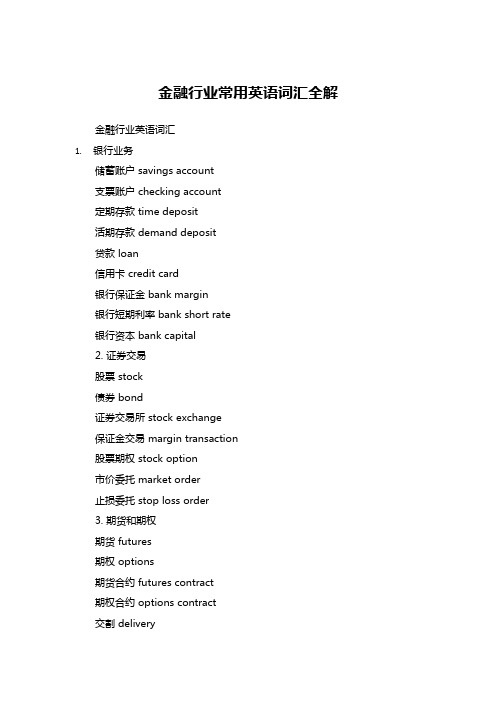
金融行业常用英语词汇全解金融行业英语词汇1.银行业务储蓄账户 savings account支票账户 checking account定期存款 time deposit活期存款 demand deposit贷款 loan信用卡 credit card银行保证金 bank margin银行短期利率 bank short rate银行资本 bank capital2. 证券交易股票 stock债券 bond证券交易所 stock exchange保证金交易 margin transaction股票期权 stock option市价委托 market order止损委托 stop loss order3. 期货和期权期货 futures期权 options期货合约 futures contract期权合约 options contract交割 delivery权利金 option premium保证金 margin4. 投资管理投资组合 investment portfolio 资产配置 asset allocation风险评估 risk assessment投资收益 investment return 资本增值 capital appreciation 价值投资 value investing成长投资 growth investing 5. 保险产品人寿保险 life insurance健康保险 health insurance汽车保险 auto insurance财产保险 property insurance 责任保险 liability insurance保险单 insurance policy保险费 insurance premium 6. 信贷与债务信贷 credit债务 debt信用评级 credit rating债务人 debtor债权人 creditor抵押贷款 mortgage loan商业贷款 commercial loan 7. 宏观经济指标国内生产总值 GDP消费者物价指数 CPI生产者物价指数 PPI失业率 unemployment rate利率 interest rate通货膨胀率 inflation rate法定准备金率 reserve requirement ratio 货币政策 monetary policy。
金融方面的专业英语词汇
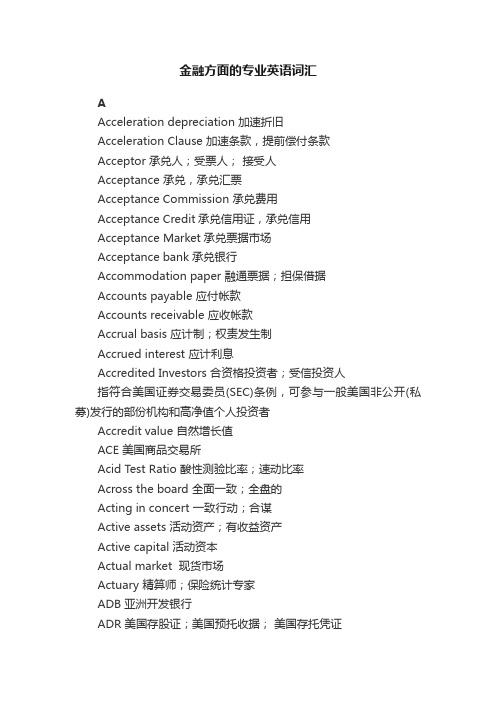
金融方面的专业英语词汇AAcceleration depreciation 加速折旧Acceleration Clause 加速条款,提前偿付条款Acceptor 承兑人;受票人;接受人Acceptance 承兑,承兑汇票Acceptance Commission 承兑费用Acceptance Credit承兑信用证,承兑信用Acceptance Market承兑票据市场Acceptance bank承兑银行Accommodation paper 融通票据;担保借据Accounts payable 应付帐款Accounts receivable 应收帐款Accrual basis 应计制;权责发生制Accrued interest 应计利息Accredited Investors 合资格投资者;受信投资人指符合美国证券交易委员(SEC)条例,可参与一般美国非公开(私募)发行的部份机构和高净值个人投资者Accredit value 自然增长值ACE 美国商品交易所Acid Test Ratio 酸性测验比率;速动比率Across the board 全面一致;全盘的Acting in concert 一致行动;合谋Active assets 活动资产;有收益资产Active capital 活动资本Actual market 现货市场Actuary 精算师;保险统计专家ADB 亚洲开发银行ADR 美国存股证;美国预托收据;美国存托凭证ADS 美国存托股份Ad valorem 从价;按值Affiliated company 关联公司;联营公司After date 发票后,出票后After-market 后市Agreement 协议;协定All-or-none order 整批委托Allocation 分配;配置Allotment 配股Alpha (Market Alpha) 阿尔法;预期市场可得收益水平Alternative investment 另类投资American Commodities Exchange 美国商品交易所American Depository Receipt 美国存股证;美国预托收据;美国存托凭证 (简称“ADR ”参见ADR栏目)American Depository Share 美国存托股份Amercian Stock Exchange 美国证券交易所American style option 美式期权Amex 美国证券交易所Amortizable intangibles 可摊销的无形资产Amortization 摊销Amsterdam Stock Exchange 阿姆斯特丹证券交易所Annual General Meeting 周年大会Annualized 年度化;按年计Annual report 年报;年度报告Anticipatory breach 预期违约Antitrust 反垄断APEC 亚太区经济合作组织(亚太经合组织)Appreciation [财产] 增值;涨价Appropriation 拨款;经费;指拨金额Arbitrage 套利;套汇;套戥Arbitration 仲裁Arm's length transaction 公平交易Arrears拖欠,欠款Articles of Association 公司章程;组织细则At-the-money option 平价期权;等价期权ASEAN 东南亚国家联盟 (东盟)Asian bank syndication market 亚洲银团市场Asian dollar bonds 亚洲美元债券Asset Allocation 资产配置Asset Backed Securities 资产担保债券Asset Management 资产管理Asset swap 资产掉期Assignment method 转让方法;指定分配方法ASX 澳大利亚证券交易所Auckland Stock Exchange 奥克兰证券交易所Auction market 竞价市场Authorized capital 法定股本;核准资本Authorized fund 认可基金Authorized representative 授权代表Australian Options Market 澳大利亚期权交易所Australian Stock Exchange 澳大利亚证券交易所BBack-door listing 借壳上市Back-end load 撤离费;后收费用Back office 后勤办公室Back to back FX agreement 背靠背外汇协议Bad check空头支票,坏票,退票Bad debts risk坏账风险Bailout指相关机构对周转有问题的银行提供财务援助的措施,如融资Balance of payments 国际收支平衡;收支结余Balance of trade 贸易平衡Balance sheet 资产负债表Balloon maturity 期末放气式偿还Balloon payment 最末期大笔还清Bancogiro银行资金划拔制度Bank, Banker, Banking 银行;银行家;银行业Bank account银行往来账户Bank Charge银行手续费(来澳洲的之前一定要问清楚,我吃亏了)Bank for International Settlements 国际结算银行Bank holding company 银行控股公司Bank interest 银行存款利息,银行贷款利息Bankruptcy 破产Bank loan银行贷款Base day 基准日Base rate 基准利率Basis point 基点;点子Basis swap 基准掉期Bear market 熊市;股市行情看淡Bearer 持票人Bearer stock 不记名股票Behind-the-scene 未开拓市场Below par 低于平值Benchmark 比较基准Beneficiary 受益人Beta (Market beta) 贝他(系数);市场风险指数Best practice 最佳做法;典范做法Bills department 押汇部Bill of exchange 汇票BIS 国际结算银行Blackout period 封锁期Block trade 大额交易;大宗买卖Blue chips 蓝筹股Blue Sky [美国] 蓝天法;股票买卖交易法Board of directors 董事会Bona fide buyer 真诚买家Bond market 债券市场,债市Bonds 债券,债票Bonus issue 派送红股Bonus share 红股Book value 帐面值Bookbuilding 建立投资者购股意愿档案;建档;询价圈购BOOT 建造;拥有;经营;转让BOT 建造;经营;转让Bottom line 底线;最低限度Bottom-up 由下而上(方法)Bounced cheque 空头支票Bourse 股票交易所(法文)BP (Basis Point) 基点Brand management 品牌管理Break-up fees 破除协议费用Break-up valuation 破产清理价值评估Breakeven point 收支平衡点Bridging loan 临时贷款/过渡贷款Broad money 广义货币Broker, Broking,Brokerage House 经纪;证券买卖;证券交易;证券行;经纪行Brussels Stock Exchange 布鲁塞尔证券交易所BSSM 建造/设备供应-服务/维修Bubble economy 泡沫经济Build, Operate and Transfer 建造、经营、转让Build, Own, Operate and Transfer 建造;拥有;经营;转让Build/Supply-Service/Maintain 建造/设备供应-服务/维修Bull market 牛市;股市行情看涨Bullets 不得赎回直至到期(债券结构之一)Bullish 看涨; 看好行情Bundesbank 德国联邦银行;德国央行Business day 营业日Business management 业务管理;商务管理;工商管理Business studies 业务研究;商业研究Buy-back 回购Buy-side analyst 买方分析员Buyer's credit 买方信贷(进口)Buyout 收购;买入By-law 细则;组织章程CCAC 巴黎CAC指数CAGR 复合年增长率Calendar year 月历年度Call-spread warrant 欧洲式跨价认股权证Call option 认购期权Call protection/provision 赎回保障/条款Call warrant 认购认股权证Callable bond 可赎回债券Cap 上限Capacity 生产能力;产能CAPEX 资本支出Capital Adequacy Ratio 资本充足比率Capital base 资本金;资本基楚Capital expenditure 资本支出Capitalization >资本值Capital markets 资本市场;资金市场Capital raising 融资;筹集资金Carry trade 利率差额交易;套利外汇交易;息差交易Cash-settled warrant 现金认股权证Cash earnings per share 每股现金盈利Cash flow 现金流量CCASS 中央结算及交收系统CD 存款证CDS 参见Credit Default Swap栏目CEDEL 世达国际结算系统(即欧洲货币市场结算系统) Ceiling 上限Ceiling-floor agreement 上下限协议Central Clearing & Settlement System 中央结算及交收系统CEO 行政总栽;行政总监;首席执行官CEPA 即2003年6月29日于香港签署的《内陆与香港关于建立更紧密经贸关系的安排》,是英文“The Closer Economic Partnership Arrangement (CEPA) between Hong Kong and the Mainland”的简称。
金融英语词汇解释汇总

Absorption 吸收,一国对最终商品和劳务的总支出,包括一国的实际消费支出、实际投资支出、实际政府支出和对进口商品和劳务的实际支出。
Absorption Approach 吸收论,一种关于国际收支和汇率决定的理论,强调一国的支出(或者称为“吸收”)及收入的作用。
根据吸收论,如果一国的实际收入超过它所吸收的商品和劳务数量,那么该国的经常账户将出现盈余;如果一国的实际收入小于它所吸收的商品和劳务数量,那么该国的经常账户将出现赤字。
Absorption Instrument 吸收工具,一国政府通过改变对国内产出的购买或通过影响消费和投资支出来提高或降低该国吸收水平的能力。
Adverse Selection 逆向选择,发行融资工具的公司将借来的资金用于低价值、高风险的投资项目的倾向。
Aggregate Demand Schedule 总需求曲线,实际收入和价格水平的各种组合,这些组合使得IS -LM 模型达到均衡,从而保证了实际收入等于总计划支出并且实际货币余额市场也实现均衡。
Aggregate Expenditures Schedule 总支出曲线,描述了在各种实际国民收入水平下相应的家庭部门、公司部门和政府部门计划支出的总和。
Aggregate Net Autonomous Expenditures 总净自主性支出,可以看作与国民收入水平无关的自主性消费、自主性投资、自主性政府支出和自主性出口支出的总量。
Aggregate Supply Schedule 总供给曲线,描述在各种可能的价格水平下相应的所有工人和公司的实际产出的曲线。
American Option 美式期权,在合同到期之前(包括到期日在内),持有者可以随时买入或者卖出某种证券的期权合约。
Announcement Effect 公告效应,中央银行的政策措施信号引起人们对近期市场条件变化的预期,从而导致私营市场利率或者汇率的变化。
Assignment Problem 政策指派问题,关于中央银行和财政部究竟谁应当对达到一国国内或者国际政策目标负责的问题。
- 1、下载文档前请自行甄别文档内容的完整性,平台不提供额外的编辑、内容补充、找答案等附加服务。
- 2、"仅部分预览"的文档,不可在线预览部分如存在完整性等问题,可反馈申请退款(可完整预览的文档不适用该条件!)。
- 3、如文档侵犯您的权益,请联系客服反馈,我们会尽快为您处理(人工客服工作时间:9:00-18:30)。
第六章1、Premiums保费Insurance companies sell insurance policies,which are legally binding contracts for which the policyholder pays insurance premiums2、Risk bearers风险承担者According to the insurance contract,insurance companies promise to pay specified sums contingent on the occurrence of future events, such as death or an automobile accident.For insurance companies, they accept or underwrite给...保险;承诺支付the risk in return for an insurance premium2、Underwriting process销售过程It is deciding which applications for insurance they should accept and which ones they should reject,and if they accept,determining how much they should charge for the insurance3、Life Insurance人寿保险For life insurance,the risk insured against is the death of the“insured”.4、Health insurance健康保险In the case of health insurance,the risk insured is medical treatmentof the insured.5、Property and casualty insurance财产与意外伤害保险The risk insured by Property and casualty(P&C)insurance companies is damage to various types of property.Specifically,it is insurance against financial loss caused by damage,destruction,or loss to property as the result of an identifiable event that is sudden, unexpected,or unusual.6、Liability Insurance责任保险The risk insured against is litigation,or the risk of lawsuits against the insured due to actions by the insured or others.7、Disability Insurance伤残险It insures against the inability of employed persons to earn an income 8、Long-Term Care Insuranc e长期护理保险It provides custodial care for the aged who are no longer able to care for themselves9、Annuity年金It is often described as a mutual fund in an insurance wrapper.It is treated as an insurance product and as a result receives a preferential tax treatment.Specifically,the income and realized gains are not taxable if not withdrawn from the annuity product.It can be eitherfixed,or variable.10、Bankassurance银行保险Insurance companies are attracted by commercial bank customer contacts.As a result,commercial bank distribution of insurance company products has grown considerably.11、Stock Insurance Company股份保险公司It is similar in structure to any corporation or public company.Shares (of ownership)are owned by independent shareholders and are traded publicly.The shareholders care only about the performance of their shares,that is,the stock appreciation and the dividends.The insurance policies are simply the products or business of the company.11、Reinsure再保险Some insurance companies may reinsure some or all of the liabilities they incur in providing insurance.According to the reinsurance transaction,the initial insurer保险公司,承保人transfers the risk of the insurance to another company,。
reinsurer再保险人,who accept the risk incurred by the primary insurance company.12、Term life insurance定期人寿保险It is pure life insurance.If the insured dies while the policy is intact,the beneficiary of the policy receives the death benefit.If the insured does not die within the period,the policy is invalid and has no value.There is no cash value or investment value for a term insurance policy.In addition,the policyholder cannot borrow against the policy.13、Whole life insurance终身险In addition to providing pure life insurance,it builds up a cash value or investment value inside the policy.This cash value can be withdrawn and can also be borrowed against by the owner of the policy.If the owner wishes to let the policy lapse,he or she can withdraw the cash value.14、Survivorship(Second to Die)Insurance最后生存者寿险An added dimension of the whole life policies is that two people are jointly insured and the policy pays the death benefit not when the first person dies,but when the second person dies.This is called survivorship insurance or second-to-die insurance.15、General account products一般账户产品The general account of an insurance company refers to the investment portfolio of the overall company.Insurance companies must support the guaranteed performance of their general account products to the extent of their solvency.16、Separate account products独立账户产品Other types of insurance products receive no guarantee from the insurance company’s general account,and their performance is not based on the performance of the insurance company’s general account but solely on the performance of an account separate from the general account of the insurance company,often an account selected by the policyholder.These products are called separate account products.。
